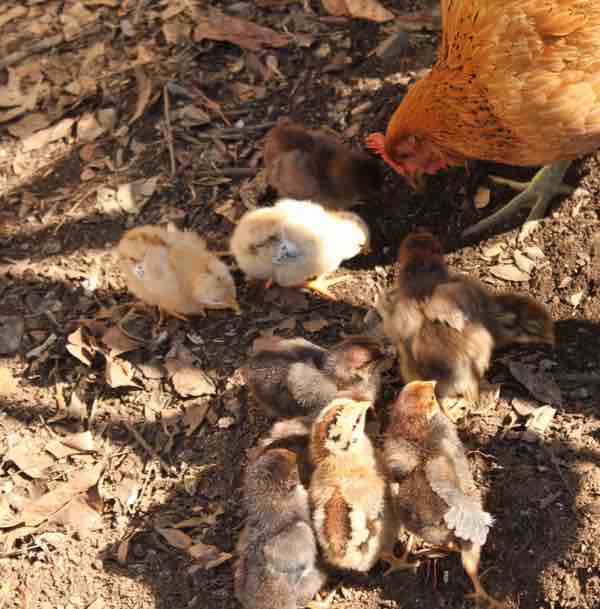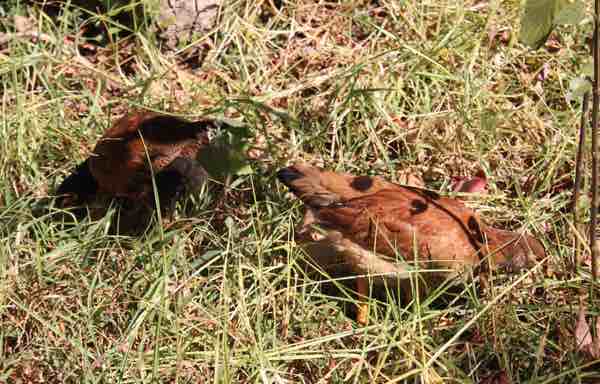- Bernard Preston homepage
- Chickens
- Raising Chicks
Raising chicks
Raising chicks from a hen is actually quite routine when you have a good mother; she does all the work. Nevertheless don't start counting before they hatch.
The first step is to acquire a hen from a breed that will get broody and sit happily for three weeks keeping her eggs warm, and turning them daily; our Leghorns are hopeless. They have been bred to lay and not rear chicks.
Therein lies the trick; not too many because if they are not turned, the eggs will not hatch. Not more than ten to start with and for a young mother on her first-brood, there is nothing wrong with five.

That means once she starts to sit, you must remove her from the other hens otherwise they will sneak in and keep laying their own eggs in the nest, like cuckoos; and they may peck and damage hers.
Then suddenly she is perching on nineteen as happened just recently; none hatched.
The second question is that of a cockerel. Are you going to have one? One can always borrow a handsome young fellow for a few weeks from a friend. It is best to catch him at night after they have gone to roost; then it is dead-easy.
Cockerels are rowdy but it will mean fertilized-eggs too and a more natural flock.
Once the hen has started to sit, you can return him. Actually, unless there are restrictions, you will probably want to keep your rooster; the hens are much happier and he does care for them.
An old runner-carpet draped over the roost douses ninety percent of the predawn crowing.
Raising chicks
Raising chicks does mean some planning and working out exactly what your long term intentions are. Mind you, chooks in the garden are a growing thing; you probably initially had no plans to have broody hens.
So you have a hen who you think will brood and have access to a cockerel. What is next? You will need a nest where she can lay her eggs and raise her chicks in privacy; it needs to be secure and dry. It is useful if it is mobile and you can move it about.
We use old grass catcher boxes from the local lawnmower-centre. It is absolutely essential to have a nest of dry grass, leaves or a piece of old carpet on the plastic, or the eggs get cold.
If the box is laying directly on the earth, place some thermal insulation underneath first.
Old swimming pool motor covers with a piece cut out of the side with an angle-grinder will keep your hen in the catcher box dry.
Keeping your broody hen secure from the creatures of the night is your next consideration; if you have snakes, foxes and genets then a proper fence where all your birds can be kept is obviously important.
I have read and simply have done it without question, that the nest needs to be relatively near to the main-flock. The chicks must hear them clucking and crowing.
Free range
We want only free-range eggs, so that is what I write about, but it does add difficulties. Hens do not like you stealing them and once a hen becomes broody she will start to lay in the wild where you can't find them. They have to be fenced in during the mornings when they are laying and hopefully she will start laying in the catcher box, and probably the others too.
Some breeds like Leghorns are so inbred that they will not lay and brood eggs suitable for raising chicks, so you may have to discriminate between them.
Then one day you'll notice that your hen turns into an angry puffball, blowing up her feathers and especially the tail into a fan and attacking any other birds that come near; she is broody.
She will start making a shrill sound if any of the others come near the nest. However they may still force their way in and lay in the box; that must be stopped.
Note the day on the calendar and remove the catcher-box with your hen sitting on her eggs and move it to a private area where she can nest in peace.
She will barely leave the nest for three weeks, and eats hardly a thing. But make sure she has fresh-water and some choice food. Fresh greens, corn and our real-bread scraps are their favourites.
Don't count your chickens
It is not for nothing that there's an old saying, do not count your chickens before they hatch. You are into a big learning curve, one filled with adventure and wonder, but disappointments too.
I write here about how you can avoid some of these disappointments, but you will have your own. It is not a reason to give up, but to persevere. One of our hens had three miscarriages in a row, not one chick, from which we gleaned some of the errors we were making.
Recently another hen snuck into the nesting area when the mother went for a drink; and pecked out every single egg. She must be secure from her own jealous sisters.
A proper grass and leaf nest, warm and dry, is essential, and do not allow the other hens to cuckold her once she starts sitting. A place that is secure from hawks and eagles and other wild creatures; you will lose a few, so accept it.
There are millions of chickens but very few crowned eagles and genets left is our philosophy. We are willing to share, but be careful or they will take the lot.
Day 22
And then suddenly on day-22, and perhaps a little earlier, you will start raising chicks in earnest. The first little face appears, a few heart rending little pipes and within a day or two you will have a nest full of tiny bundles of feathers, shouting for their breakfast.
Your can read more about that at best chick food.
At three months you have to make a big, and difficult decision. Are these chicks pets or are they for food. We have started slaughtering the cockerels. If you are unable to do that, you must give them away; they are rowdy, randy and will terrorise the egg-laying hens.
I have not tried rearing chicks under an infrared lamp.

When browsing use right click and "Open Link in New Tab" or you may get a bad gateway signal.
Newsletter
Our newsletter is entitled "create a cyan zone" at your home, preserving both yourself and Mother Earth for future generations; and the family too, of course. We promise not to spam you with daily emails promoting various products. You may get an occasional nudge to buy one of my books.
Here are the back issues.
- Lifestyle and ideal body weight
- What are ultra-processed foods?
- Investing in long-term health
- Diseases from plastic exposure
- Intensive lifestyle management for obesity has limited value
- A world largely devoid of Parkinson's Disease
- The impact of friendly bacteria in the tum on the prevention of cancer
- There's a hole in the bucket
- Everyone is talking about weight loss drugs
- Pull the sweet tooth
- If you suffer from heartburn plant a susu
- Refined maize meal and stunting
- Should agriculture and industry get priority for water and electricity?
- Nature is calling
- Mill your own flour
- Bake your own sourdough bread
- Microplastics from our water
- Alternative types of water storage
- Wear your clothes out
- Comfort foods
- Create a bee-friendly environment
- Go to bed slightly hungry
- Keep bees
- Blue zone folk are religious
- Reduce plastic waste
- Family is important
- What can go in compost?
- Grow broad beans for longevity
- Harvest and store sunshine
- Blue zone exercise
- Harvest and store your rainwater
- Create a cyan zone at your home
Did you find this page interesting? How about forwarding it to a friendly book or food junkie? Better still, a social media tick would help.
- Bernard Preston homepage
- Chickens
- Raising Chicks
Address:
56 Groenekloof Rd,
Hilton, KZN
South Africa
Website:
https://www.bernard-preston.com